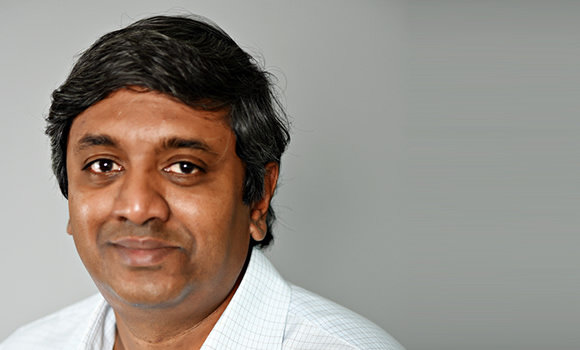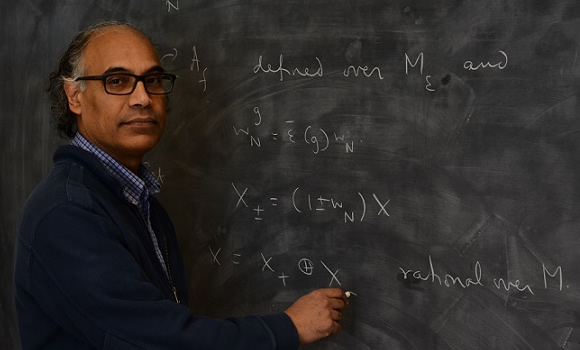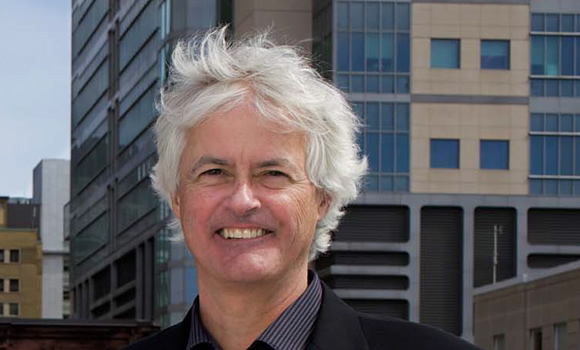There’s big buzz around big data — a key area of focus for a number of Arts & Science disciplines. Mining the vast quantity of information now available holds unimaginable promise: predicting and preventing crime, optimizing business, tackling diseases, even the discovery of new planets. Yet our ability to generate data exceeds our ability to analyze it, a key challenge for scientists in many A&S fields.
Here’s what the heads of our computer science, mathematics and statistical sciences departments see coming soon.
Ravin Balakrishnan
Chair, Department of Computer Science
Computer scientists will find themselves playing larger roles in the transformation of the global knowledge economy as the world moves further into this age of big data.
The explosion of big data in recent years has led to a need to better manage the massive amount of information being collected by machines every second, but also an opportunity to use this data to find solutions to real problems.
As Canada’s foremost centre for computational and data sciences research, we’re aiming to harness our scholarship in data analytics, machine and deep learning, accelerated computation and even networking and storage capabilities. The goal is to help researchers make better sense of the increasing amounts of data at their fingertips, so we can solve global problems in areas such as the environment, health and medicine, as well as cities and urban infrastructure.
More cross-university collaboration
I hope to see a lot more cross-university collaboration between computer science and seemingly disparate disciplines. A good example is our work with the Faculty of Law for its Blue J Legal tax law research application.
A just-launched research group investigating sustainability informatics, led by Professor Steve Easterbrookand researchers from the Faculty of Information, will focus on the role of computer and information sciences in enabling human society to thrive for the long term. By connecting researchers interested in various aspects of sustainability in other departments, the group will explore ways to achieve sustainability across several domains: personal (health and well-being); social (just and equitable societies); economics (flow of resources and capital); technical (physical and computations infrastructures) and, environmental (healthy ecosystems and stable climate).
Key area: transportation
Transportation is another aspect of our lives to which computer science will contribute more than ever before. Algorithms developed here at U of T by researchers such as Assistant Professor Raquel Urtasun, for example, will lead to better software for use in self-driving cars, making them increasingly safer and more viable for getting around.
V. Kumar Murty
Chair, Department of Mathematics
The nature of mathematical research is undergoing an evolution with several trends emerging. One of these is the role of computational techniques as a means of predicting or guessing what should be true, as well as verifying or providing a new tool in actual proofs. This is why we will introduce training in computation techniques at the undergraduate and graduate levels. Professor Dror Bar-Natan will be running our first graduate course in computational techniques this year.
Blurring of the line between pure and applied mathematics
Another important trend is the blurring of the line between pure and applied mathematics. A particularly visible example of this is the emergence of data science. The world is being engulfed in a tsunami of information that is begging to be analyzed. This analysis demands new tools and mathematicians are digging deep into their arsenal of pure mathematical techniques to devise these novel tools. Recently recruited from Stanford, Assistant Professor Hau-Tieng Wu is leading the charge on this, and is already engaged in a large collaboration with several of the teaching hospitals in the University Health Network.
More generally, we find that in an increasingly digitized world, quantitative modelling and analysis have assumed great importance. Mathematics, and a mathematical way of looking at things, is becoming fundamental in many fields. This is one of the reasons we are strengthening and significantly expanding our research and teaching capacity in applied mathematics. The Centre for Applied Mathematics, set to launch in 2016, will focus on mathematical finance, imaging, fluids, optimal transport, big data and information security. These are areas in which we are currently active and we hope to expand that activity, both in terms of research and teaching.
Solving centuries-old problems
Remarkable progress is being made on problems that have been viewed as inaccessible for centuries. The most dramatic instance of this was the recent proof of the existence of primes with bounded gaps. Primes are the building blocks of all numbers and understanding their distribution has been a secret of the mathematical universe. While it had long been conjectured that primes sometimes bunch up close to each other — the so-called bounded gaps — this has now been proved, thanks in large part to our own University Professor John Friedlander, giving us new insight into the structure of numbers.
I expect that 2016 will see additional developments which highlight more than ever the importance of supporting basic curiosity-driven research as we do not know how and when such breakthroughs will come.
Jamie Stafford
Chair, Department of Statistical Sciences
As a discipline, statistical science emerged from various scientific domains. It has evolved as inseparable from computer science and central to machine learning. How appropriate that the data revolution sweeping nearly every facet of academic and daily life aligns with the current directions of statistical science, as we embrace the emergence of large-scale data as one of this century’s greatest scientific, and societal, advances and challenges.
The increasing ability to collect large and complex data sets provides strong impetus for new research in statistical science, and for new interdisciplinary collaborations. This data acquisition trend is accompanied by an increasing demand for statistical expertise and has led to an entirely new type of professional — the data scientist.
Data models are becoming increasingly complex
As data become ubiquitous and easier to acquire, particularly on a massive scale, data models are becoming increasingly complex. There is a wealth of algorithmic and heuristic tools for the analysis of these models, but it is only in the past few years that formal statistical tools for assessment and inference have become available.
Typically these complex models involve a regularization component to control for a range of variables. These models need to address new data structures, including network data, image data and streaming data. Development of statistical theory for describing the properties of classical tools in the new data regime, and the development of new inferential methods that extend the classical tools, is a very active area of research.
Methods for sparse modeling and for dimension reduction are undergoing rapid development. Computationally viable methods for visualization of large-scale data, for the analysis of data from computer experiments, and for inferential tools based on resampling are needed.
Uncertainty quantification, new methods of sampling, and theoretical analysis of widely used ‘divide and recombine’ methods for inference are among the research areas needing substantial development. Reproducibility of statistical and computational methods, as part of a new push for completely reproducible research, is built on aspects of theoretical statistics and of computational theory and methods.
Expertise at the interface of the computational and statistical sciences
Finally the emergence of large-scale complex data in every facet of academic and daily life has been accompanied by an increasing demand for expertise at the interface of the computational and statistical sciences — particularly machine learning. The importance of this interface has only grown in time — a trend that argues for the continuing integration of the two disciplines.
No professional statistician can possibly hope to make a meaningful contribution in collaboration or research without a serious computational skill-set. Conversely, computer scientists need far more adequate statistical training to fully understand the behaviour and impact of the tools and algorithms they invent. Within the machine learning community the integration of the two disciplines can be expressed in extreme ways with the late computer scientist Sam Roweis commenting at the beginning of a keynote address: “it took me 10 years to realize I was a statistician” and Radford Neal, a statistician and computer scientist, recently quipping: “all of statistics is machine learning.”




